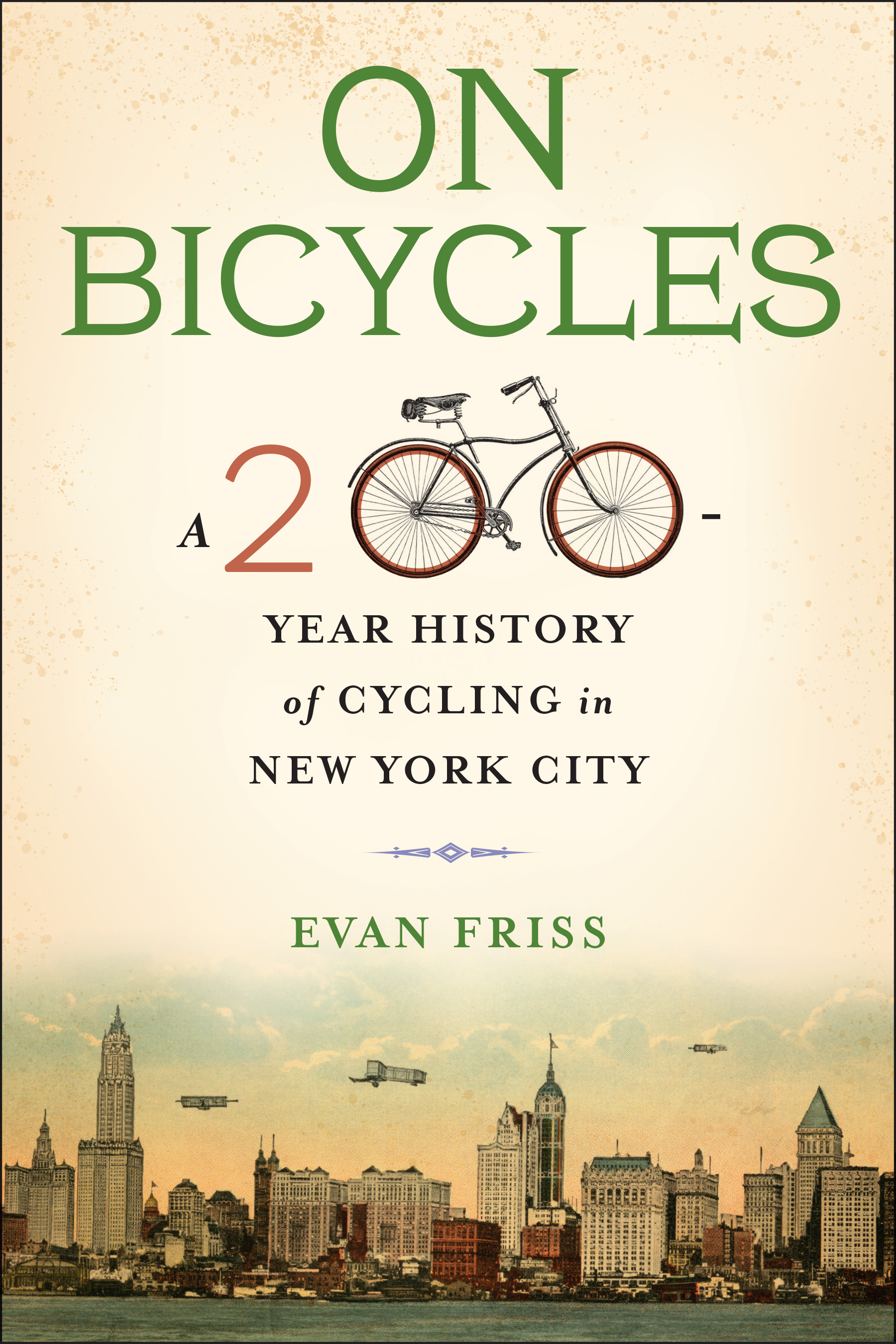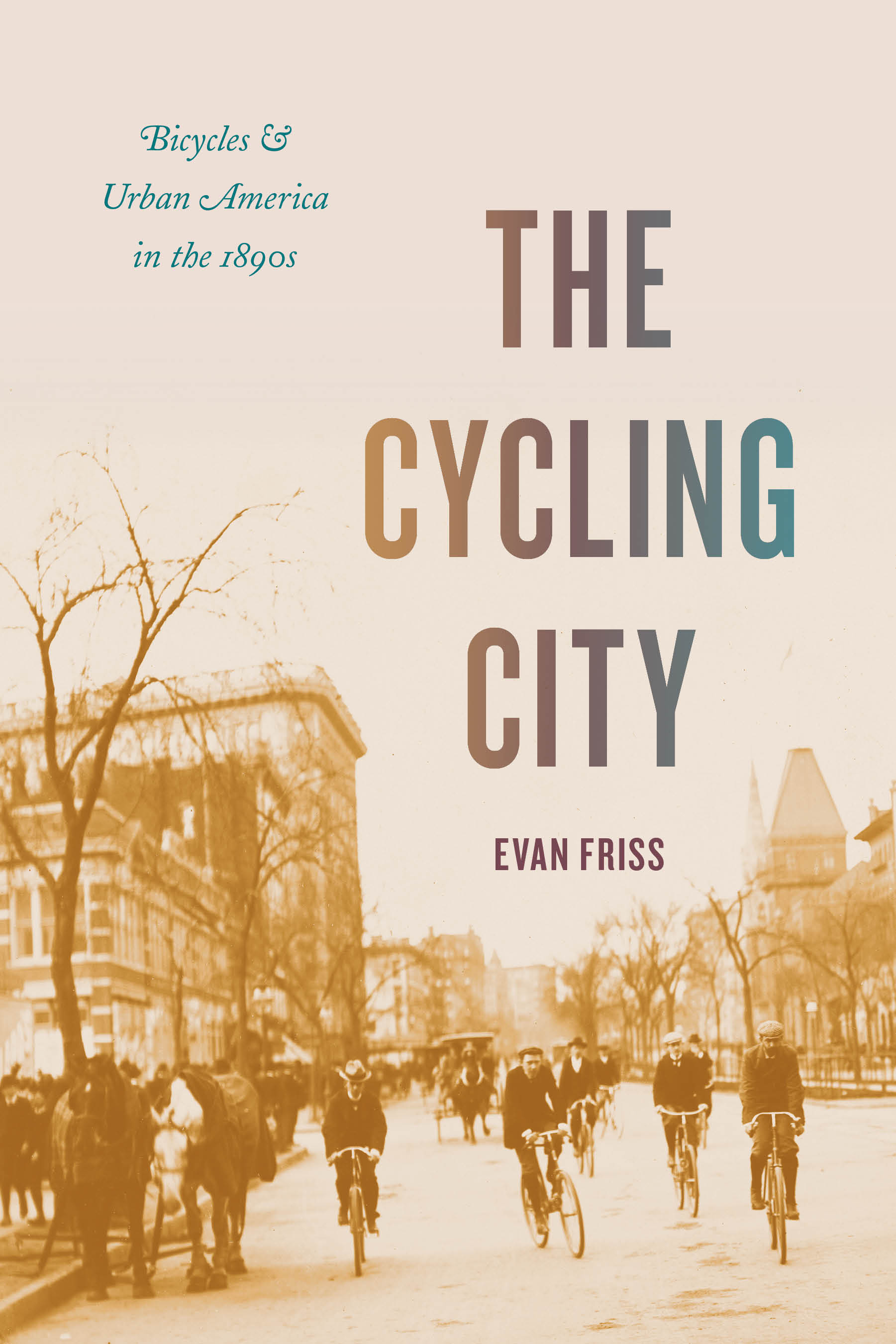 On Bicycles: A 200-Year History of Cycling in New York City (Columbia University Press, 2019)
On Bicycles: A 200-Year History of Cycling in New York City (Columbia University Press, 2019)
Subways and yellow taxis may be the icons of New York transportation, but it is the bicycle that has the longest claim to New York’s streets: two hundred years and counting. Never has it taken the streets without controversy: 1819 was not only the year of the city’s first bicycle, but its first bicycle ban. Debates around the bicycle’s place in city life have been so persistent not just because of its many uses—recreation, sport, transportation, business—but because of changing conceptions of who cyclists are.
In On Bicycles, Evan Friss traces the colorful and fraught history of bicycles—and bicyclists—in New York City. He uncovers the bicycle’s place in the city over time, showing how the bicycle has served as a mirror of the city’s changing social, economic, infrastructural, and cultural politics since it first appeared. It has been central, as when horse-drawn carriages shared the road with bicycle lanes in the 1890s; peripheral, when Robert Moses’s car-centric vision made room for bicycles only as recreation; and aggressively marginalized, when Ed Koch’s battle against bike messengers culminated in the short-lived 1987 Midtown bike ban. On Bicycles illuminates how the city as we know it today—veined with over a thousand miles of bicycle lanes and dotted with bicycles—reflects a fitful journey powered—and opposed—by New York City’s people and its politics.
REVIEWS
“This is a thoughtful, entertaining look at an essential form of transportation in New York City.” (Publishers Weekly)
“In On Bicycles, Evan Friss fills in the missing chapters that bicycles hold in New York City’s near-miraculous transportation history, and shows how the city’s streets are finally catching up with them.” (Janette Sadik-Khan, Bloomberg Associates, former NYC Transportation Commissioner)
“Two hundred years ago, the first riding machines that resembled what would become bicycles began pouring into Manhattan, and New York City would never be the same again. On Bicycles is brilliantly researched, noting the battles against local government, sexism, the automobile, and the railways, as the bicycle fought its way to become more popular today than ever before. Vive le vélo!” (Phil Liggett, “The Voice of Cycling”)
“This social history of the transformation of New York’s relationship to cycling is elegantly researched, gracefully written, and nearly as delightful as the bicycle itself.” (Kim Phillips-Fein, author of Fear City: New York’s Fiscal Crisis and the Rise of Austerity Politics)
“Witty and wise, engaged and engaging, surprising, fun and fabulous—I’m running out of adjectives to describe Evan Friss’s wondrous new book. Move over Amsterdam: New York City is a bicycling city too, though with fits and starts, grunts and guffaws, and more than a handful of bike haters (some in high places). A great way to learn about the history of the city that never sleeps—and has never stopped arguing about its bicycles and bicyclists.” (David Nasaw, Arthur M. Schlesinger, Jr. Professor of History, CUNY Graduate Center)

The Cycling City: Bicycles and Urban American in the 1890s (University of Chicago Press, 2015)
Cycling has experienced a renaissance in the United States, as cities around the country promote the bicycle as an alternative means of transportation. In the process, debates about the nature of bicycles—where they belong, how they should be ridden, how cities should or should not accommodate them—have played out in the media, on city streets, and in city halls. Few people realize, however, that these questions are more than a century old.
In the 1890s, American cities were home to more cyclists, more cycling infrastructure, more bicycle-friendly legislation, and a richer cycling culture than anywhere else in the world. Evan Friss unearths the hidden history of The Cycling City, demonstrating that diverse groups of cyclists managed to remap cities with new roads, paths, and laws; challenge social conventions; and even dream up a new urban ideal inspired by the bicycle. When cities were chaotic and filthy, bicycle advocates imagined an improved landscape in which pollution was negligible, transportation was silent and rapid, leisure spaces were democratic, and the divisions between city and country were blurred. Friss argues that when the utopian vision of a cycling city faded by the turn of the twentieth century, its death paved the way for today’s car-centric cities—and ended the prospect of a true American cycling city ever being built.
REVIEWS
“Friss has a good story to tell. In the late nineteenth century, bicycles were not just a sweet means of romantic transport–‘Daisy, Daisy, give me your answer do,’ and all that–but a technological triumph creating fanatical followers and interest groups. The bicycle was more like a personal computer than like a love seat…Friss is a demon researcher, and his book is full of revelatory facts…” (Adam Gopnik, The New Yorker)
“Evan Friss’s The Cycling City: Bicycles and Urban America in the 1890s deserves recognition as the definitive account of the 1890s bicycle ‘boom’ in the United States.” “Friss’s book also presents a story that deserves a wide readership, one that would benefit both academic and popular readers…scholars and popular readers will appreciate the book’s admirable blend of historical detail and colorful, often vivid storytelling.” “What sets this book apart is its exceptional research.” “The book shows that Friss scoured not only the early bicycling industry’s immense material culture, including everything from club uniforms and banners, to tool kits and pneumatic tires and maps, but also more traditional historical sources, such as municipal records, newspaper articles, manuscript collections, and diaries.” “Friss has produced a truly indispensable volume relevant far beyond his likely readers in urban history.” “Combining exceptional research and clear-eyed analysis, Friss has produced an accessible yet authoritative account, an accomplishment in and of its own…It seems impossible now to tell the story of the US city, the automobile, or the nation’s urban landscape without first considering the bicycle craze of the last decade of the nineteenth century. Friss, in other words, has taken an essential step in reinserting the bicycle into American history…” (Winterthur Portfolio)
Friss “refuses to homogenise riding practices, insisting throughout on the multiplicity of meanings and practices that the term ‘cyclist’ can cover. Importantly, his comparative stance exposes the recursive relationship between cities and their transport and mobility systems” “There is a high degree of theoretical sophistication in his analysis of place and the processes of construction.” “Friss refuses to be drawn into crass connections with 21st century bicycle transport policy debates: nevertheless, his study carefully shows than an historical analysis is deeply pertinent to those debates.” (Journal of Transport History)
“Friss offers a deeply researched, highly textured account of urban cycling in the 1890s.” (Reviews in American History)
“The Cycling City is aided by sharp prose, illustrations and graphs, and a well-researched narrative. By contextualizing cycling in environmental, urban, and cultural terms, the author makes a fine contribution to sports history and the history of cities, one that will appeal to scholars in various disciplines.” (Journal of Sport History)
“This is an interesting and readable discussion of the bicycle’s role in the US in the 1890s.” (Choice)
“Friss rejects as overly simplistic the standard explanation that motor vehicles replaced bicycles as a mode of transportation once cyclists abandoned their machines for motor vehicles demonstrating persuasively that the vogue for cycling had already ended by the time that automobile registrations and sales began increasing…Urban and cultural historians will find much of interest in this fine study.” (Journal of American History)
“His interdisciplinary study makes welcome contributions to environmental, urban, and cycling history and draws our attention to the inextricable ties among all three, in modern as well as historical contexts…One might argue cogently that transportation is the single most direct avenue in any quest to confront environmental degradation…Friss understands this, and he invites readers to park their automobiles, pedal back to 1895, and share in cyclists’ utopian visions of future cities…That journey is time is strengthened by the author’s depth of research that documents the remarkable extent to which the bicycle penetrated so many aspects of American society during that period…Friss’s study points in pioneering directions.” (Environmental History)